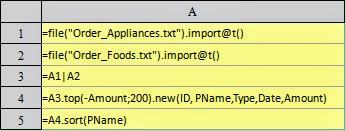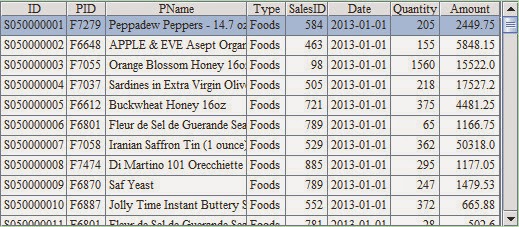Please look at the following case. List top 200 transaction records of all household appliances orders and food orders according to total order amount, and sort by product names. Order records come from two text files: Order_Appliances.txt and Order_Foods.txt. First summarize the data in the two sheets, get top 200 order records in total order amount, and then sort by product names.
Computed
results of all cells are as follows:
The table
sequence in A1 contains order records of Order_Appliances.txt:The table sequence in A2 contains order records of Order_Foods.txt:
A3 combines records of the two table
sequences simply for the use of filtering in the next step.
A5 sorts top 200 order records of sales amount by product names as required:
In fact, what we really need finally is
the data in A5. After A4 gets all the necessary information of order records,
the information in original cells A1 and A2 becomes useless. Deleting these
useless data after getting intermediate data can release memory and make the
operations more steady.
If cell value is set as null, the data in
the cell would be deleted, as shown by statements in C3 and B4. After statement
in C3 deletes the cell value of A2 and B4 deletes the data in A3 referencing
records of food orders, the original food orders will be removed from memory.
We can choose the method for deleting cell
values as needed. Setting cell value as null is more commonly used. T.reset() is used only when the table sequence’s data structure is really
need retaining.
Note that though statement in B5 sets the
value of A4 as null, it cannot reduce memory footprint. Because the result A5
returns is a record sequence in which records come from the table sequence in
A4, these records cannot be deleted and will be still in use in A5 even if A4
is set as null. Therefore, when the method of setting cell values as null is to
be used, we must find out whether data in the cell is being used or not.
In addition, A5 sorts records in A4, but
the execution won’t produce new records. What A5 stores is merely the references
resulted from sorting records, which have a limited memory footprint and won’t increase
memory usage.








No comments:
Post a Comment